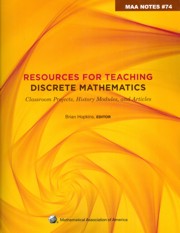Book contents
- Frontmatter
- Introduction
- Dedication
- Contents
- I Classroom-tested Projects
- II Historical Projects in Discrete Mathematics and Computer Science
- III Articles Extending Discrete Mathematics Content
- A Rabbi, Three Sums, and Three Problems
- Storing Graphs in Computer Memory
- Inclusion-Exclusion and the Topology of Partially Ordered Sets
- IV Articles on Discrete Mathematics Pedagogy
- About the Editor
Inclusion-Exclusion and the Topology of Partially Ordered Sets
from III - Articles Extending Discrete Mathematics Content
- Frontmatter
- Introduction
- Dedication
- Contents
- I Classroom-tested Projects
- II Historical Projects in Discrete Mathematics and Computer Science
- III Articles Extending Discrete Mathematics Content
- A Rabbi, Three Sums, and Three Problems
- Storing Graphs in Computer Memory
- Inclusion-Exclusion and the Topology of Partially Ordered Sets
- IV Articles on Discrete Mathematics Pedagogy
- About the Editor
Summary
Introduction
It is surprising and satisfying that the principle of inclusion-exclusion, a well-known combinatorial tool, is a special case of a more general phenomenon that also gives rise to the classical Möbius function of number theory. Specifically, the principle of inclusion-exclusion is equivalent to Möbius inversion on the Boolean lattice, while the classical Möbius function arises from Möbius inversion on the lattice of divisors. Generalized Möbius inversion was developed by Gian-Carlo Rota [8] in 1964.
To use Möbius inversion, one must be able to compute the value of what is known as the generalized Möbius function. This function provides a link between combinatorics and topology and motivates a broader exploration of the topology of partially ordered sets.
We will begin by using the principle of inclusion-exclusion to derive a formula for the Euler totient function. This will lead us to define the classical Möbius function, which turns out to be the generalized Möbius function of D, the lattice of divisors. We will use D as a point of departure to explain generalized Möbius inversion. Then, we will compute the Möbius function for the Boolean lattice B and show that Möbius inversion on B gives rise to the principle of inclusion-exclusion. We will conclude with a discussion of poset topology.
In this purely expository article, our intent is to convey some connections between number theory, combinatorics, and topology. For this reason, we do not work in full generality and leave unproved some of the results that we use.
- Type
- Chapter
- Information
- Resources for Teaching Discrete MathematicsClassroom Projects, History Modules, and Articles, pp. 293 - 302Publisher: Mathematical Association of AmericaPrint publication year: 2009



